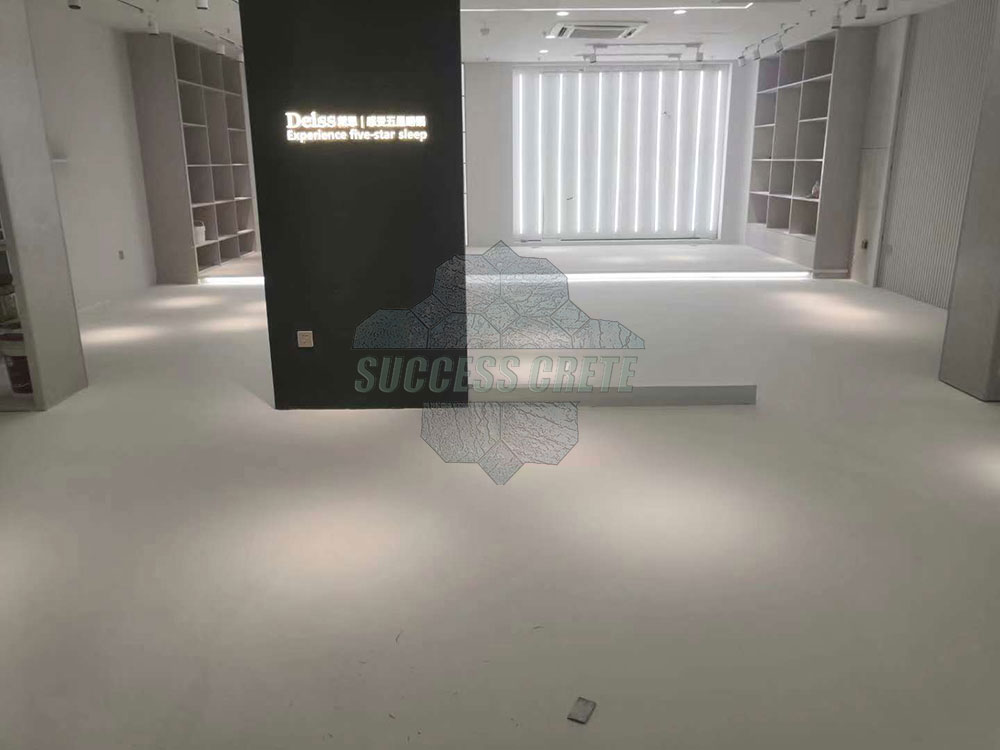In this blog, we will detail:
- Introduction
- Benefits of Self-Leveling Concrete underlayment
- Applications of Self-Leveling Concrete underlayment
- Preparation of Self-Leveling underlayment pad for Installation
- Factors to Consider When Selecting a Self-Leveling Concrete underlayment
- Conclusion
- A . Review the benefits of self-leveling concrete bedding. B. Encourage everyone to consider self-leveling concrete pads for future projects.
Introduction
Definition of Self-Leveling Concrete underlayment
Self-leveling concrete underlayment is a type of cementitious material that is applied as a thin layer on top of existing concrete or another substrate surface to create a level, smooth, and even surface.
The underlayment can range from 1/8 inch to 1 inch thick and is designed to provide a flat, even surface for the installation of floor coverings, such as tile, carpet, or wood.
Self-leveling concrete underlayment is made up of a blend of cement, sand, and polymer additives that allow it to flow and self-level, filling in low spots, and creating a smooth surface without the need for extensive manual labor.
The material is typically mixed with water and poured onto the surface to be covered.
Once poured, the underlayment will seek its own level and flatten itself out, creating a uniform surface.
Self-leveling concrete underlayment is commonly used in both residential and commercial applications.
It is particularly useful in situations where the existing concrete substrate has uneven areas, rough spots, or other surface imperfections that would prevent the installation of traditional floor coverings.
Self-leveling concrete underlayment can be used over a variety of substrates, including concrete, wood, tile, and even some types of resilient flooring.
In addition to providing a level surface for floor coverings, self-leveling concrete underlayment can also improve the overall durability of the finished floor.
It can help to reduce cracking and other types of damage that can occur over time, particularly in high-traffic areas.
Additionally, some self-leveling concrete underlayments are designed to provide a moisture barrier, which can help to protect the finished flooring from moisture-related damage.
Overall, self-leveling concrete underlayment is an excellent solution for creating a smooth, level surface for a variety of flooring applications.
Its ease of use, durability, and versatility make it a popular choice for both residential and commercial applications.
Importance of Self-Leveling Concrete underlayment
Self-leveling concrete underlayment is an important material used in construction to create a smooth and level surface for flooring installations.
Here are some of the key reasons why self-leveling concrete underlayment is important.
Leveling.
Self-leveling concrete underlayment is used to level uneven or rough concrete surfaces, creating a smooth and level substrate for flooring installations.
This is especially important for high-traffic areas where uneven floors can be a safety hazard.
Adhesion.
Self-leveling concrete pads have a strong bond to the substrate, ensuring that the flooring material adheres well and does not separate from the surface, etc
Overall, self-leveling concrete bedding is an important material in construction, providing a durable, level, and moisture-resistant surface for the installation of flooring materials.
It is a versatile material that can be used in a wide range of applications, making it a valuable tool for construction professionals.
Benefits of Self-Leveling Concrete underlayment
- Smooth surface
- Durability
- Cost-effectiveness
- Time-saving
- Compatibility with various surfaces
Self-leveling concrete underlayment is a popular flooring option that offers several benefits, including:
A. Smooth surface:
Self-leveling concrete underlayment creates a smooth and level surface that is perfect for installing various types of flooring, such as tile, hardwood, or carpet.
This is because the self-leveling compound flows and spreads evenly across the surface, filling in low spots and creating a flat and even base for the flooring.
B. Durability:
Self-leveling concrete underlayment is highly durable and can withstand heavy foot traffic, abrasion, and impact. It also has excellent compressive strength, which makes it an ideal choice for high-traffic areas such as commercial and industrial spaces.
C. Cost-effectiveness:
Self-leveling concrete underlayment can be a cost-effective solution compared to other methods of leveling a concrete surface. It is relatively quick and easy to install, which means less labor time and lower installation costs. Additionally, it can help to reduce the amount of material required for the final flooring, which can further reduce the overall cost of the project.
In addition to the benefits of self-leveling concrete underlayment mentioned earlier, there are a couple of other advantages worth noting:
D. Time-saving:
Self-leveling concrete underlayment is a quick and efficient solution for leveling a concrete surface. It can be applied in a single layer and sets quickly, allowing for the installation of the final flooring within a short time frame.
This can save both time and money on the overall project, especially when compared to traditional concrete leveling methods.
E. Compatibility with various surfaces:
Self-leveling concrete underlayment is compatible with various types of surfaces, including concrete, plywood, and OSB(https://en.wikipedia.org/wiki/Oriented_strand_board) (oriented strand board).
This means that it can be used to level a range of subfloors, making it a versatile solution for different flooring projects.
In summary, self-leveling concrete underlayment offers time-saving benefits and is compatible with various surfaces, making it a versatile and efficient solution for leveling a concrete surface and preparing it for the final flooring installation.

Applications of Self-Leveling Concrete underlayment
- Residential
- Commercial
- Industrial
- Institutional
Self-leveling concrete underlayment has many applications across various sectors, including residential, commercial, industrial, and institutional. Some of the common applications are:
A. Residential:
Leveling subfloors: Self-leveling underlayment can be used to level subfloors that have uneven surfaces, preparing them for floor installation.
Repairing damaged concrete: Self-leveling underlayment can be used to repair damaged concrete floors in a residential setting, creating a smooth and even surface.
B. Commercial:
Retail spaces: Self-leveling underlayment can be used to level floors in retail spaces, creating a seamless and attractive surface for customers.
Hospitality industry: Self-leveling underlayment can be used in hotels, resorts, and other hospitality spaces to level floors and create a safe and visually appealing surface.
C. Industrial:
`Warehouses: Self-leveling underlayment can be used to level floors in warehouses, making it easier to move heavy equipment and products around the space.
`Manufacturing facilities: Self-leveling underlayment can be used to level floors in manufacturing facilities, ensuring a safe and even surface for workers and equipment.
`Educational facilities: Self-leveling underlayment can be used in educational facilities to level floors in classrooms, gyms, and other areas.
`Healthcare facilities: Self-leveling underlayment can be used in healthcare facilities to create a smooth and even surface that is easy to clean and maintain.
Self-leveling concrete underlayment has many applications across various sectors and is an excellent solution for creating a smooth, level, and visually appealing surface.
Preparation of Self-Leveling underlayment Pad for Installation
- Surface Preparation
- Mixing of the substrate material
- Application Techniques
Preparing a self-leveling underlayment pad for installation typically involves the following steps:
A. Surface preparation:
Remove any existing floor covering, adhesive, or debris from the subfloor.
Check the subfloor for any cracks, holes, or unevenness that may need to be repaired before installing the underlayment pad.
Clean the subfloor thoroughly and allow it to dry completely before proceeding.
B. Mixing of the substrate material:
Read the manufacturer’s instructions carefully before mixing the self-leveling underlayment pad.
Combine the substrate material and water in the recommended ratio, typically using a power mixer or drill with a mixing paddle attachment.
Mix thoroughly until a smooth and consistent texture is achieved, making sure to scrape the sides and bottom of the mixing container to ensure all the material is evenly mixed.
C. Application Techniques:
Pour the mixed self-leveling underlayment pad onto the subfloor, starting at the furthest point from the exit.
Use a gauge rake to spread the material evenly over the subfloor, maintaining the recommended thickness for the specific product.
Use a smoothing tool, such as a trowel or smoothing blade, to smooth out any bumps or ridges in the surface and to ensure an even finish.
Allow the self-leveling underlayment pad to dry completely before installing any flooring on top. The drying time will vary depending on the product and the thickness of the layer, so consult the manufacturer’s instructions for specific guidance.
Note:
It’s important to follow the manufacturer’s instructions carefully when preparing and installing a self-leveling underlayment pad to ensure optimal performance and durability.

Factors to Consider When Selecting a Self-Leveling Concrete underlayment
- Type of surface
- Level of traffic
- Moisture content
- Temperature and humidity
When selecting a self-leveling concrete underlayment, there are several factors to consider to ensure that the installation is successful and long-lasting. Here are some of the key factors to keep in mind:
A. Type of surface:
The type of surface that the underlayment will be applied to is an important consideration. Self-leveling underlayments can be used on a variety of surfaces, including concrete, wood, and tile. However, it’s important to choose an underlayment that is specifically designed for the type of surface you’re working with.
B. Level of traffic:
The level of foot traffic or vehicular traffic that the underlayment will be exposed to is another important consideration. If the area will be subject to heavy traffic, you’ll need to choose an underlayment that is strong and durable enough to withstand wear and tear.
C. Moisture content:
Moisture can be a big issue when it comes to self-leveling underlayments. If the surface is damp or has a high moisture content, you’ll need to choose an underlayment that is designed to work in these conditions. There are also moisture barriers and primers that can be used to help prevent moisture from causing problems.
D. Temperature and humidity:
Temperature and humidity can also affect the performance of self-leveling underlayments. Some underlayments are better suited to higher temperatures or higher humidity levels than others.
It’s important to choose an underlayment that is appropriate for the temperature and humidity conditions of the installation site.
Overall, the key is to choose an underlayment that is specifically designed to meet the unique needs of your installation.
By considering factors like surface type, traffic level, moisture content, and temperature/humidity, you can ensure that you choose the right underlayment for your project.
Conclusion
A. Self-leveling concrete pads offer numerous advantages, including
Leveling and Smoothing Uneven Surfaces:
Self-leveling concrete bedding can be used to level and smooth uneven floors, creating a flat surface.
Cost-effective:
Self-leveling concrete pads are more cost-effective than traditional concrete placement methods because they require fewer workers and equipment.
Fast Installation:
Self-leveling concrete pads can be installed quickly and efficiently, reducing the overall time required for flooring projects.
Durability:
Self-leveling concrete pads are a durable material that can withstand heavy foot traffic and other wear and tear.
Versatility:
Self-leveling concrete pads can be used for a variety of applications, including residential, commercial, and industrial flooring.
B. If you are planning a flooring project in the near future, consider using self-leveling concrete underlayment
Not only is it a cost-effective option, but it also provides a long-lasting and durable flooring solution.
Consult a professional contractor to determine if a self-leveling concrete pad is right for your specific project needs.
If you have additional needs or questions, please feel free to contact our team of professionals and we will take care of you immediately!





